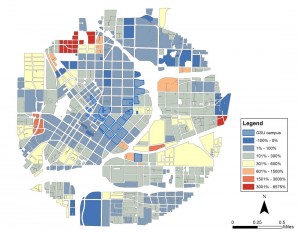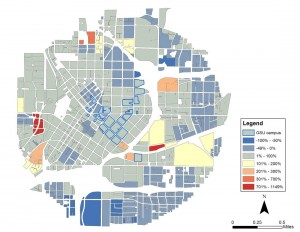Georgia State has had a substantial influence on Atlanta’s economy. The urban research institution attracts companies to the city, its students inject a considerable amount of capital into the municipal economy each year, and property values in the city have risen along with the university’s expansion.
Businesses are relocating to Atlanta at startling rates to be near some of the large urban research Universities here, mainly Georgia Tech and Georgia State. Over the last decade, Tech Square, the eight square block area in Midtown designed for the use of large research companies and Georgia Tech students, has seen 12 Fortune 500 corporate research centers relocate to it. These companies, including big names such as AT&T, Panasonic, and Coca-Cola, along with smaller technology startups are just a few examples of the growing trend of businesses relocating to be near urban universities.
What’s driving this trend of companies moving to be near urban universities is the changing landscape of partnership within the private sector. Private companies are becoming increasingly aware of the external sources of support they gain from these universities. In the past, large technologically focused companies tended to isolate themselves from others because they had more or less of a monopoly on the market in which they focused. (Andes, et al.) In 1960 for example, DuPont was the leading polymer company in the world. DuPont greatly innovated in polymer science, inventing essential materials such as nylon and Kevlar we now use daily. All of this was done, however, from its closed off research campus in Wilmington, Delaware. Businesses of the time sought to create new markets where these futuristic technologies had not yet existed. (Andes, et al.) In the 21st century, few companies can still monopolize the technology they rely upon to effectively work. There is also a lot more rapid competition among these companies. Consider the tablet computer, the first iteration of which to be widely used by mainstream consumers was released by Apple in 2010 in the form of the iPad. The next year at the Consumer Electronics Show, almost a dozen competing tablet computers were on display. Today, companies aren’t as focused on making fundamental research technology as they are on “leveraging” it (Andes, et al.) from universities and learning from other firms and researchers located in dense, urban cities such as Atlanta.
When corporations relocate, most of the time it’s towards cities home to leading research universities that incentivize student engagement in the private sector. Such universities including Georgia Tech and Georgia State in Atlanta, MIT in Cambridge, and Washington University in St. Louis have all seen corporate research centers move to the outskirts of their campuses not only because they are located in cities, but also because universities encourage students and faculty to work with these buisnesses. GSU and Georgia Tech reward postgraduates for patenting their work, working with small businesses, and they implore faculty to seek federal grants supporting research projects with the help of the private sector. (Andes, et al.)
Especially in a city like Atlanta, where businesses of all kinds are relocating, there is no shortage of job opportunities for students graduating from these areas. And businesses are looking for just these types of workers. At Georgia State, I rarely find a time when there aren’t hundreds of flyers for job fairs and internship seminars taking place on campus, rife with businesses and organizations looking for young, intellectual students that the urban research institution provides.
The increased number of residence halls on campus has brought more and more of these students into the city. Since 2002, new residence halls have brought almost 4,000 students within walking distance of the campus’ core. These students spend money both on and off campus, funneling capital into the municipal economy. According to 2011-12 academic year data, GSU had a total of 32,022 students enrolled. According to their estimates, a GSU resident spends $3,384 in the city, a commuter student living at home spends $5,974, and a commuter not living at home spends $13,774 in the city. While we can’t assume all of this was spent exclusively in downtown Atlanta, it’s fair to say that a large portion of it was. Based on data from GSU, Ericson was able to calculate that no less than $10 million enters downtown Atlanta’s economy from GSU’s student population each year. And as GSU continues to expand and bring more residents and commuters to downtown Atlanta each year, this number is sure to increase.
Property values have risen in downtown Atlanta along with GSU’s expansion as well. Steven Ericson, a GSU graduate, conducted a study to assess whether GSU’s campus expansion has increased surrounding property values in 2014. He obtained shape files from the Fulton County Board of Assessors for all of the properties in Fulton County on an annual basis from 2000 to 2012. He narrowed the data down to focus on properties within a one-mile radius of Dahlberg Hall, one of the core buildings on GSU’s campus. Using this data, Ericson measured the change in property values during GSU’s expansion. He found that land near the university has increased in value since 2000. The increases ranged from 1 to 100 percent, so it’s hard to say the extent to which GSU has had a hand in increasing these values, but it has had an influence nevertheless. From 2007 to 2012, properties bordering the downtown campus have increased more substantially.
During this period, GSU opened its residence halls University Commons and Piedmont North in 2007 and 2008 respectively. These halls brought nearly 3000 students to downtown Atlanta. Data shows that by this point, 93 percent of the properties bordering GSU’a Atlanta campus have increased in value. Georgia State plays a significant role in maintaining and furthering downtown Atlanta’s economic vitality.



